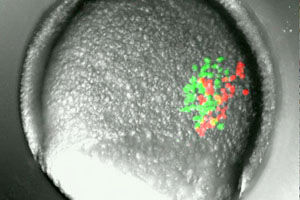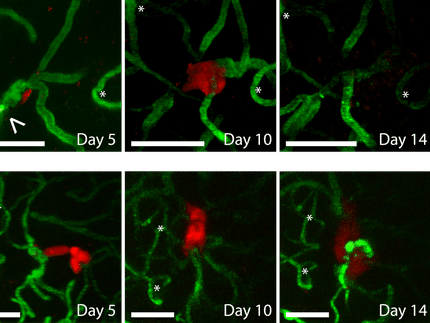Dynamic new connections
Researchers of the University of Freiburg decode a signal activating the first cell movements in the embryo
A research team of the University of Freiburg has elucidated the molecular control mechanisms that transform the initially tightly cohesive earliest cells of the zebrafish embryo so that the first major cell migration in their development is initiated.

Groups of red and green labelled cells in a zebrafish during their first migration.
Wolfgang Driever
A better understanding of cell migration is of high biomedical relevance. Whereas for a healthy human or animal body cell movements are for example essential for wound healing, it may be lethal when cancer cells start to migrate into the body and induce metastases. Cell migration can be studied especially well during embryogenesis of model organisms such as the zebrafish, because it develops in the water, and the movements of each cell can be observed under the microscope.
Following fertilization of the egg, during the next cell divisions all cells of the embryo have to stick together tightly. Otherwise the embryo may split into parts. Shortly thereafter, cells have to start to migrate to build the germ layers of the embryo. To accomplish this, the tight connections have to be resolved. The biologists from Freiburg were able to show that the important stem cell factor Oct4 controls the synthesis of a signal, the epidermal growth factor (EGF), which in turn controls the transport of the crucial cell adhesion molecule E-Cadherin from the cell membrane to the interior of the cell in endosomes. These mechanisms regulate the activity of E-Cadherin at the cell membrane and enable cells to dynamically form new connections and start to move.
The project was performed in the Collaborative Research Center (SFB 850) "Control of Cell Motility in Morphogenesis, Cancer Invasion and Metastasis". The results are relevant for potential mechanisms involved in cancer metastasis, because similar regulations involving EGF and E-Cadherin contribute to the so-called epithelio-mesenchymal transition that may initiate tumour invasion. Furthermore, the contribution of the stem cell factor Oct4 is crucial to study the properties of cancer stem cells.
Original publication
Most read news
Other news from the department science

Get the life science industry in your inbox
By submitting this form you agree that LUMITOS AG will send you the newsletter(s) selected above by email. Your data will not be passed on to third parties. Your data will be stored and processed in accordance with our data protection regulations. LUMITOS may contact you by email for the purpose of advertising or market and opinion surveys. You can revoke your consent at any time without giving reasons to LUMITOS AG, Ernst-Augustin-Str. 2, 12489 Berlin, Germany or by e-mail at revoke@lumitos.com with effect for the future. In addition, each email contains a link to unsubscribe from the corresponding newsletter.






















































